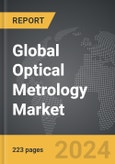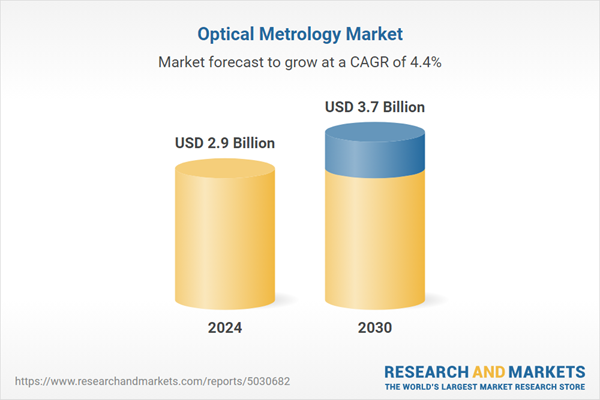The global market for Optical Metrology was valued at US$2.9 Billion in 2024 and is projected to reach US$3.7 Billion by 2030, growing at a CAGR of 4.4% from 2024 to 2030. This comprehensive report provides an in-depth analysis of market trends, drivers, and forecasts, helping you make informed business decisions. The report includes the most recent global tariff developments and how they impact the Optical Metrology market.
Segments: Segment (Optical / Laser Scanners, Video Measuring Machines, Laser Micrometry); End-Use (Automotive, Aerospace & Defense, Consumer Electronics, Medical, Other End-Uses).
Geographic Regions/Countries: World; United States; Canada; Japan; China; Europe (France; Germany; Italy; United Kingdom; Spain; Russia; and Rest of Europe); Asia-Pacific (Australia; India; South Korea; and Rest of Asia-Pacific); Latin America (Argentina; Brazil; Mexico; and Rest of Latin America); Middle East (Iran; Israel; Saudi Arabia; United Arab Emirates; and Rest of Middle East); and Africa.
The analysts continuously track trade developments worldwide, drawing insights from leading global economists and over 200 industry and policy institutions, including think tanks, trade organizations, and national economic advisory bodies. This intelligence is integrated into forecasting models to provide timely, data-driven analysis of emerging risks and opportunities.
Global Optical Metrology Market - Key Trends & Drivers Summarized
How Is Optical Metrology Transforming Precision Measurement?
Optical metrology is revolutionizing precision measurement by providing highly accurate, non-contact methods for measuring physical properties such as distance, surface texture, and dimensional accuracy. Using light-based techniques like interferometry, holography, and laser scanning, optical metrology offers unparalleled precision and is widely used in industries such as aerospace, automotive, electronics, and manufacturing. These industries rely on optical metrology to ensure product quality, maintain tight tolerances, and verify the performance of critical components. In fields such as semiconductor manufacturing, where precision is essential, optical metrology is invaluable for inspecting wafers and detecting defects at the microscopic level. As manufacturing processes become more complex and precise, the demand for accurate, real-time measurement solutions is growing, making optical metrology an essential tool in modern industrial applications.What Trends Are Driving the Optical Metrology Market?
Several trends are driving the optical metrology market, particularly the increasing demand for precision and real-time measurement in high-tech industries. The rise of 3D optical metrology is a significant trend, as industries like aerospace and automotive require detailed, three-dimensional measurements of complex components and surfaces to ensure accuracy and performance. The growing adoption of Industry 4.0 and smart manufacturing is also boosting demand for optical metrology systems, which provide real-time data for optimizing production processes and improving product quality. Another trend is the increasing use of non-contact, non-destructive testing methods, which are critical in industries where contact-based measurement could damage sensitive components. Advances in digitalization and data analysis are further enhancing the capabilities of optical metrology systems, allowing for faster, more accurate measurements and better integration with automated production lines.How Is Technology Enhancing Optical Metrology?
Technological advancements are significantly enhancing the capabilities of optical metrology systems, making them more precise, efficient, and versatile. One of the most important innovations is the development of 3D optical metrology systems, which provide detailed, high-resolution measurements of complex shapes and surfaces. These systems are particularly valuable in industries like automotive and aerospace, where precise measurements are critical for ensuring performance and safety. Advances in interferometry and laser-based measurement techniques are improving the accuracy and speed of optical metrology, allowing for real-time, high-precision measurements in production environments. The integration of optical metrology with machine vision and artificial intelligence (AI) is also driving innovation, enabling automated inspection and quality control processes that reduce human error and improve productivity. Additionally, the miniaturization of optical components is enabling the development of portable, field-deployable metrology systems, expanding the range of applications for optical metrology.What Is Driving the Growth in the Optical Metrology Market?
The growth in the optical metrology market is driven by several factors, including the increasing demand for precision measurement in industries such as automotive, aerospace, electronics, and manufacturing. As these industries adopt more advanced production techniques and tighter tolerances, the need for accurate, non-contact measurement systems is growing. The rise of 3D optical metrology is also contributing to market growth, as industries seek more detailed and accurate measurements of complex geometries. The push for automation and real-time data in smart manufacturing environments is driving the adoption of optical metrology systems, which provide real-time, high-precision measurements for optimizing production processes and ensuring product quality. Additionally, the demand for non-destructive testing methods, particularly in industries such as semiconductor manufacturing and aerospace, is supporting the growth of the optical metrology market. Technological advancements, such as the integration of AI and machine vision, are further enhancing the capabilities of optical metrology systems, making them more attractive to a broader range of industries.Report Scope
The report analyzes the Optical Metrology market, presented in terms of units. The analysis covers the key segments and geographic regions outlined below.Segments: Segment (Optical / Laser Scanners, Video Measuring Machines, Laser Micrometry); End-Use (Automotive, Aerospace & Defense, Consumer Electronics, Medical, Other End-Uses).
Geographic Regions/Countries: World; United States; Canada; Japan; China; Europe (France; Germany; Italy; United Kingdom; Spain; Russia; and Rest of Europe); Asia-Pacific (Australia; India; South Korea; and Rest of Asia-Pacific); Latin America (Argentina; Brazil; Mexico; and Rest of Latin America); Middle East (Iran; Israel; Saudi Arabia; United Arab Emirates; and Rest of Middle East); and Africa.
Key Insights:
- Market Growth: Understand the significant growth trajectory of the Optical / Laser Scanners segment, which is expected to reach US$2.7 Billion by 2030 with a CAGR of a 3.7%. The Video Measuring Machines segment is also set to grow at 6.5% CAGR over the analysis period.
- Regional Analysis: Gain insights into the U.S. market, valued at $752.6 Million in 2024, and China, forecasted to grow at an impressive 7.7% CAGR to reach $828.9 Million by 2030. Discover growth trends in other key regions, including Japan, Canada, Germany, and the Asia-Pacific.
Why You Should Buy This Report:
- Detailed Market Analysis: Access a thorough analysis of the Global Optical Metrology Market, covering all major geographic regions and market segments.
- Competitive Insights: Get an overview of the competitive landscape, including the market presence of major players across different geographies.
- Future Trends and Drivers: Understand the key trends and drivers shaping the future of the Global Optical Metrology Market.
- Actionable Insights: Benefit from actionable insights that can help you identify new revenue opportunities and make strategic business decisions.
Key Questions Answered:
- How is the Global Optical Metrology Market expected to evolve by 2030?
- What are the main drivers and restraints affecting the market?
- Which market segments will grow the most over the forecast period?
- How will market shares for different regions and segments change by 2030?
- Who are the leading players in the market, and what are their prospects?
Report Features:
- Comprehensive Market Data: Independent analysis of annual sales and market forecasts in US$ Million from 2024 to 2030.
- In-Depth Regional Analysis: Detailed insights into key markets, including the U.S., China, Japan, Canada, Europe, Asia-Pacific, Latin America, Middle East, and Africa.
- Company Profiles: Coverage of players such as Carl Zeiss Optotechnik GmbH, Creaform, Inc., FARO Technologies, Inc., GOM GmbH, Hexagon Manufacturing Intelligence and more.
- Complimentary Updates: Receive free report updates for one year to keep you informed of the latest market developments.
Some of the 46 companies featured in this Optical Metrology market report include:
- Carl Zeiss Optotechnik GmbH
- Creaform, Inc.
- FARO Technologies, Inc.
- GOM GmbH
- Hexagon Manufacturing Intelligence
- KLA-Tencor
- Micro-Vu Corporation
- Mitutoyo Corporation
- Nanometrics, Inc.
- Nikon Metrology NV
- Nova Measuring Instruments Ltd.
- Perceptron, Inc.
- Quality Vision International, Inc.
- S-T Industries, Inc.
Tariff Impact Analysis: Key Insights for 2025
Global tariff negotiations across 180+ countries are reshaping supply chains, costs, and competitiveness. This report reflects the latest developments as of April 2025 and incorporates forward-looking insights into the market outlook.The analysts continuously track trade developments worldwide, drawing insights from leading global economists and over 200 industry and policy institutions, including think tanks, trade organizations, and national economic advisory bodies. This intelligence is integrated into forecasting models to provide timely, data-driven analysis of emerging risks and opportunities.
What’s Included in This Edition:
- Tariff-adjusted market forecasts by region and segment
- Analysis of cost and supply chain implications by sourcing and trade exposure
- Strategic insights into geographic shifts
Buyers receive a free July 2025 update with:
- Finalized tariff impacts and new trade agreement effects
- Updated projections reflecting global sourcing and cost shifts
- Expanded country-specific coverage across the industry
Table of Contents
I. METHODOLOGYII. EXECUTIVE SUMMARY2. FOCUS ON SELECT PLAYERSIII. MARKET ANALYSISCANADAITALYSPAINRUSSIAREST OF EUROPESOUTH KOREAREST OF ASIA-PACIFICARGENTINABRAZILMEXICOREST OF LATIN AMERICAIRANISRAELSAUDI ARABIAUNITED ARAB EMIRATESREST OF MIDDLE EASTIV. COMPETITION
1. MARKET OVERVIEW
3. MARKET TRENDS & DRIVERS
4. GLOBAL MARKET PERSPECTIVE
UNITED STATES
JAPAN
CHINA
EUROPE
FRANCE
GERMANY
UNITED KINGDOM
ASIA-PACIFIC
AUSTRALIA
INDIA
LATIN AMERICA
MIDDLE EAST
AFRICA
Companies Mentioned (Partial List)
A selection of companies mentioned in this report includes, but is not limited to:
- Carl Zeiss Optotechnik GmbH
- Creaform, Inc.
- FARO Technologies, Inc.
- GOM GmbH
- Hexagon Manufacturing Intelligence
- KLA-Tencor
- Micro-Vu Corporation
- Mitutoyo Corporation
- Nanometrics, Inc.
- Nikon Metrology NV
- Nova Measuring Instruments Ltd.
- Perceptron, Inc.
- Quality Vision International, Inc.
- S-T Industries, Inc.
Table Information
| Report Attribute | Details |
|---|---|
| No. of Pages | 223 |
| Published | April 2025 |
| Forecast Period | 2024 - 2030 |
| Estimated Market Value ( USD | $ 2.9 Billion |
| Forecasted Market Value ( USD | $ 3.7 Billion |
| Compound Annual Growth Rate | 4.4% |
| Regions Covered | Global |









